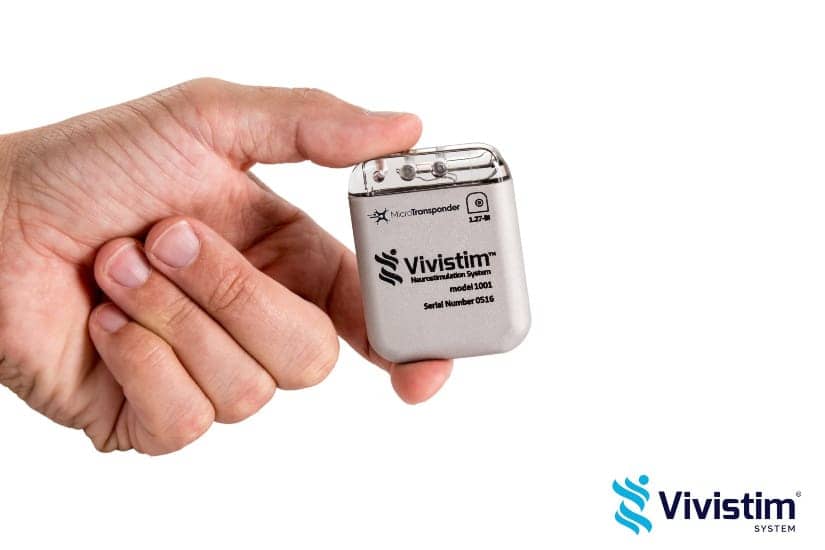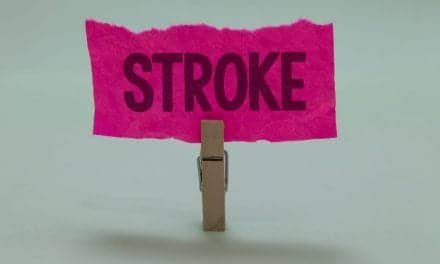Rehabilitation therapy researchers and clinicians embrace the FDA-approved, first-of-its-kind Vivistim Paired VNS System with a positive outlook as an effective, outcomes-based adjunct intervention for survivors of ischemic stroke.
Manufactured by MicroTransponder Inc, a medical device company developing solutions to restore independence and dignity for people suffering from neurological conditions that impair sensory and motor function, the Vivistim System pairs vagus nerve stimulation with rehabilitation therapy to improve upper limb function for stroke survivors.
Results of MicroTransponder’s 108-person, multicenter, triple-blinded, randomized controlled pivotal clinical trial, published in The Lancet, suggest that the Vivistim System generates two to three times more hand and arm function for stroke survivors than rehabilitation therapy alone.
These results, along with the assertion of a paradigm shift in stroke rehabilitation, were presented by Teresa Jacobson Kimberley, PhD, PT, FAPTA, a professor at MGH Institute of Health Professions, and Steven L. Wolf, PhD, PT, FAPTA, FAHA, FASNR, a professor in the Division of Physical Therapy at Emory University School of Medicine, during the American Physical Therapy Association’s 2022 Combined Sections Meeting.
Kimberley and Wolf, who led the Vivistim clinical trial at their respective institutions, facilitated a symposium titled “Applying the Evidence: The Emerging Role of Vagus Nerve Stimulation Paired with Stroke Rehabilitation.”
“The standard of care in rehabilitation therapy for stroke survivors has limited effect on the restitution of arm and hand function. The Vivistim VNS System paired with intense rehabilitation empowers occupational and physical therapists to enhance the benefits of the treatment they provide,” Kimberley says. “The evidence suggests that vagus nerve stimulation with rehabilitation therapy harnesses neurophysiology to enhance restitution.”
As Paired VNS Therapy garners more recognition for being an innovative, results-oriented intervention in stroke recovery, Wolf advocates for buy-in from rehabilitation specialists by underscoring that this new intervention is a complement to therapy, not a replacement.
“The challenge we have as neurorehabilitation professionals working with stroke survivors is changing the rate of recovery to make gains last longer before a patient’s movement ability plateaus,” Wolf says. “The use of vagus nerve stimulation may offer an opportunity to create such changes.”
Guide Patients to Mobility Improvements
According to occupational and physical therapists who participated in the clinical trial, the Vivistim System enables therapists to guide stroke survivors to significant improvements in upper limb mobility because of the innovativeness of the technology, the therapy’s unique in-clinic protocol and the system’s capability to be activated at home by the patient.
During Vivistim Therapy, a therapist will use a wireless transmitter that communicates with proprietary software to signal the implanted Vivistim device to deliver a gentle pulse to the vagus nerve while the stroke survivor performs a specific task, such as putting on a hat, brushing hair or cutting food. Through Vivistim’s at-home feature, stroke survivors can continue practicing rehabilitation exercises or practice routine tasks on their own by swiping the Vivistim magnet over the implant area.
Researchers believe that the simultaneous pairing of the rehabilitation exercise with vagus nerve stimulation releases neuromodulators that create or strengthen neural connections to improve upper limb function and increase the benefit of physical therapy.
“Paired VNS therapy is targeted to enhance neuroplasticity in the central nervous system of stroke survivors, so the exercises we conduct are more movement- and patient-specific,” says Nuray Yozbatiran, a physical therapist and research faculty member at the NeuroRecovery Research Center at TIRR Memorial Hermann and Department of Physical Medicine and Rehabilitation at UT Health McGovern Medical School.
Therapists evaluate their patient’s upper limb function during each Vivistim Therapy session to tailor the exercises around hand and arm functions that need the most improvement. According to Yozbatiran, patients reported that they felt challenged during the sessions and appreciated the intensity.
“Most of the patients I worked with during the clinical trial felt empowered with another chance at an intervention to improve their use and movement of the hemiplegic upper extremity. It motivated them to incorporate their hand and arm into tasks they had not recently performed,” says Komal Sahu, MPH, OTR/L, an occupational therapist at Emory Healthcare. “The follow-up with patients after completing the clinic sessions proved beneficial. All of the patients confirmed that they were continuing their 30-minute daily Vivistim at-home therapy and even asked for new and challenging activities to practice. It’s driven me to think of additional activities and exercises that will help my patients accomplish specific movements and goals.”
Easy to Integrate
Even though the Vivistim System protocols are extensive, most therapists in the clinical trial report that it’s easy to integrate into their practice. During the clinical trials, 71% of therapists said it was easy or very easy to trigger the vagus nerve stimulation during therapy.
“The Vivistim System has helped me maintain an effective balance, delivering the VNS, guiding the patient through tasks, and only intervening to prevent the patient from doing compensatory movements,” says Isha Vora, MS, OTR/L, an acute care occupational therapist and Ph.D. student in the Brain Recovery Lab at MGH Institute of Health Professions.
Vora adds that Paired VNS Therapy can be effective for many survivors of ischemic stroke. The ideal candidates are probably survivors who are consistent with their follow-up appointments and who are motivated to participate in rehabilitation therapy. She’s seen patients who have previously been stagnant in therapy achieve significant improvement in their hand and arm function with Vivistim Therapy.
Clinical teams are currently identifying potential candidates for the Vivistim System, with the first commercial implantation of Vivistim expected in the first half of 2022.
For more information and to assess if your patients are ideal candidates for the Vivistim System, visit Vivistim.
[Source(s): MicroTransponder, PR Newswire]





